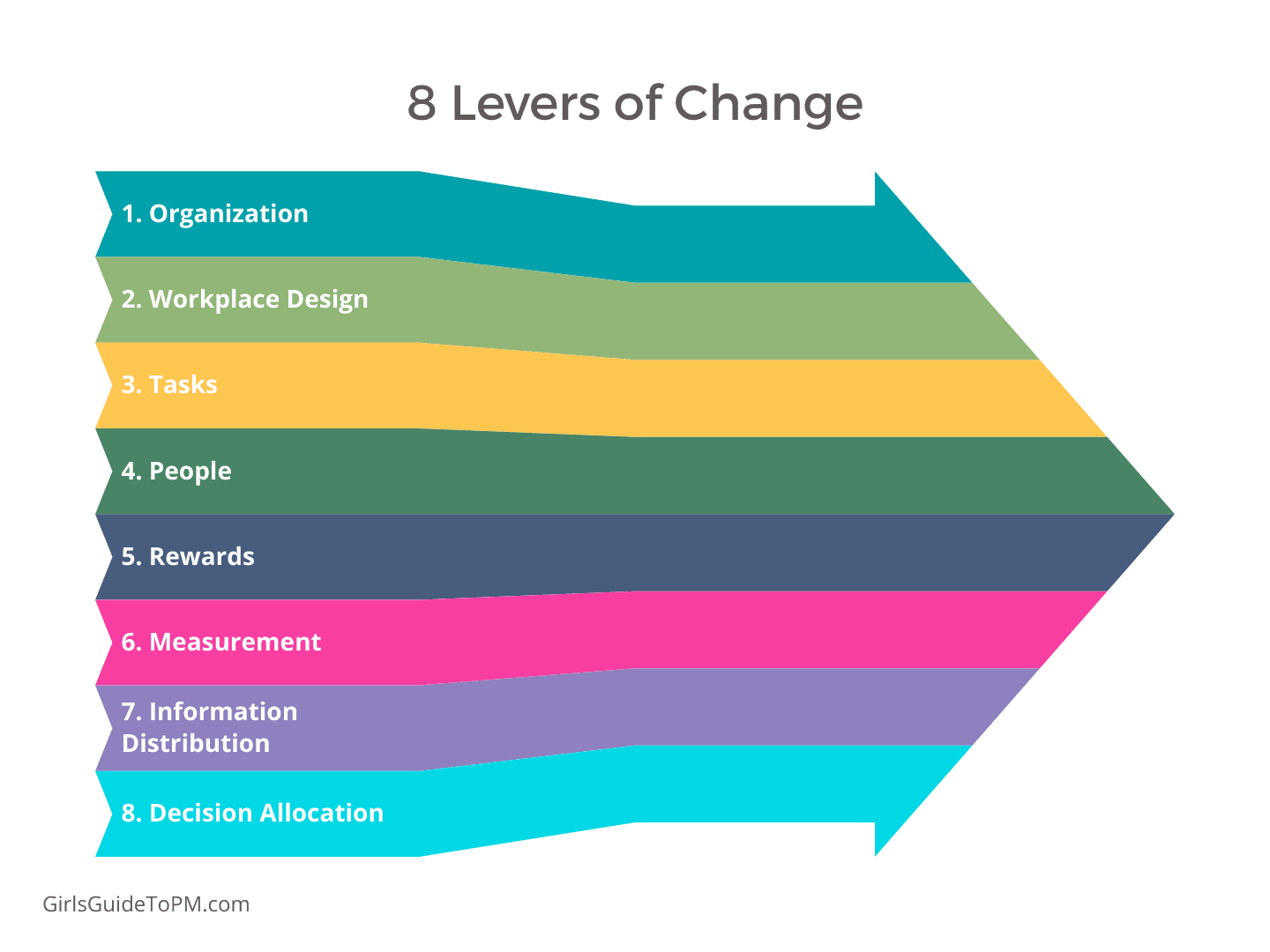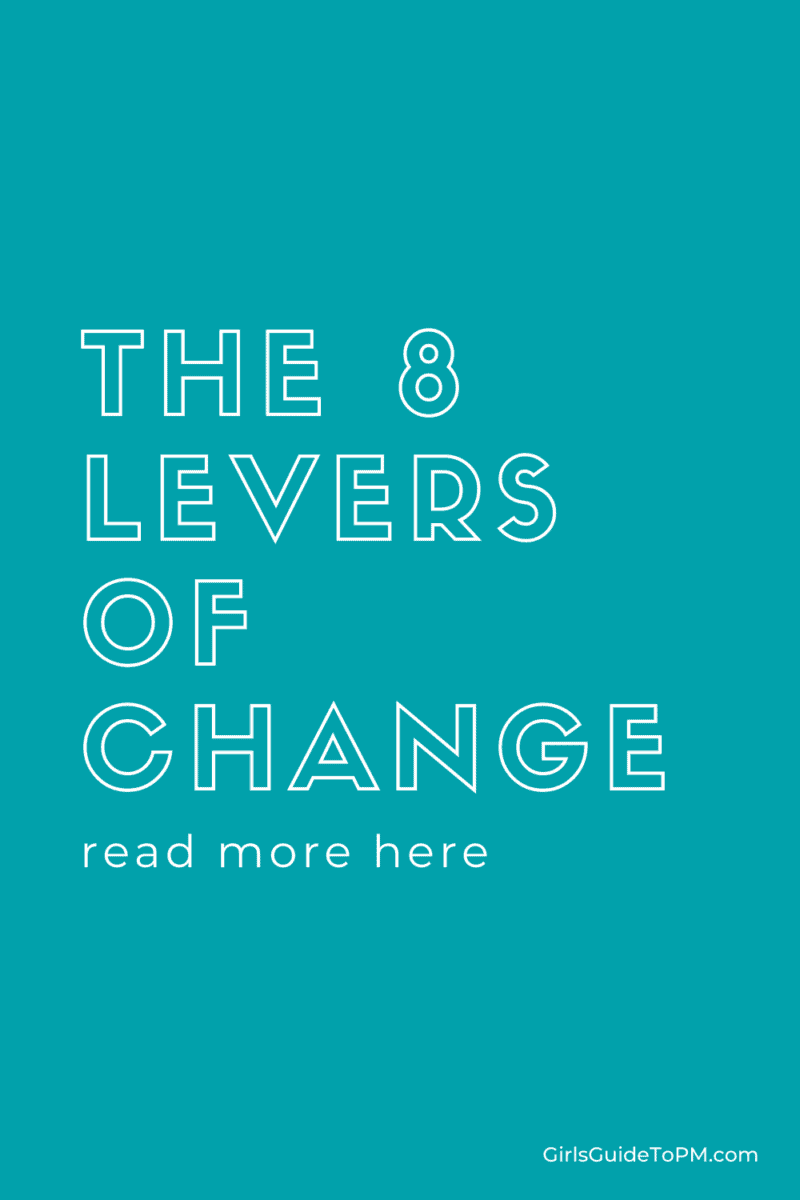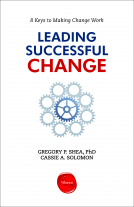The 8 Levers of Change
This blog is reader-supported. When you purchase something through an affiliate link on this site, I may earn some coffee money. Thanks! Learn more.
In their book, Leading Successful Change: 8 Keys to Making Change Work, Gregory P. Shea and Cassie A. Solomon talk about the 8 things that you should be targeting if you want the change management effort on your project to stick.
They say that if your project isn’t addressing at least 4 of these elements, then the change is doomed to fail. People will slip back into their old ways.
Moving any one of these 8 Levers of Change will alter the work environment in specific ways and send a different set of cues to those who inhabit that environment,” write Shea and Solomon. “Change enough levers enough for the owners of the behavior to perceive that the time has come to adapt to a new set of environmental cues, indeed to what qualifies as a new environment.”
So what are the things that you should be looking out for on your projects? Here are their 8 levers of change.

1. Organization
The organization element covers how things are structured in the company. What is managed centrally and what is decentralized? An example would be whether you have project managers spread across different departments or a central Project Management Office. If they are split, how will that help or hinder your drive-through change on your project?
Organizations can also be split by geography or division and this could have an impact on your ability to successfully implement change. Is there a strong emphasis on cross-functional teams or do you see most people working in silos?
These are the kinds of things you’ll need to consider for the best chance of project success. Tailor how you approach the project, and the change that it is going to deliver, in order to get the best result.
Ideally, your project should consider redesigning the organization chart if that would make the outcome more successful. You could also look at what involvement you need from other teams and how you will get this if it involves breaking down geographic barriers or silos between departments.
Managing an international team does take slightly different skills, and you can definitely learn how to do it better!
2. Workplace design
Workplace design is how the layout of the work environment affects the people working there. I once did a one-off study on business process improvement for a leadership institute and one of the things that were raised when I was interviewing the Marketing team was how much more time they felt they could save if they had their own fax machine (remember them?) instead of having to walk to a communal machine.
This was a really easy thing to fix and would have resulted in the staff feeling listened to, with the subsequent increase in morale. Naturally, this would also save time, which is beneficial for everyone. I think the management team were expecting a few more radical suggestions, but it’s the fax machine one that stuck with me — so easy to fix.
In the end, I think they did that simple change.
Having said that, Shea and Solomon argue that putting things in communal areas and closer together helps people work together as it encourages interaction. Will moving equipment or people around help you embed the change more effectively? How can technology help you achieve the same thing if you can’t physically move the people?
Collaboration tools for project managers are something else to consider in this situation. They will help people work together more effectively regardless of where they are physically based.
3. Tasks
This may seem straightforward but is worth a bit of extra attention. Just because tasks or workflows have always existed doesn’t mean they are the most efficient or successful. Taking stock of the tasks at hand and comparing those with your internal workflows can help to see if there are gaps, overlap, or even redundancies that could be optimized.
When working across different departments or teams you may want to also consult with people in those areas to check with them. Are the tasks reasonable or can they be honed in different ways? Are there any steps missing? Are there people or workflows that were missed?
Also, it’s important to think about future workflows. What tasks are required in the new world? How will people’s jobs change? Will your project result in new work processes? Consider how standardizing processes or using checklists could help you embed the change more effectively.
Talk to people during team meetings, read the results of staff surveys and just listen to the kind of grumbles that people chat about and see if that gives you any clues to what could be improved.
4. People
Shea and Solomon feel that change projects can be successful without having to recruit a whole lot of new people. If you provide adequate training, coaching, and combine that with good leadership skills, you can get the existing staff up to the level that they need to be to work effectively in the future.
Consider what new skills they will need, and what values they will need to demonstrate once your project is complete. If you’re recruiting, does your recruiting practice have to change to get people who will fit with the new work environment?
Another element to this is office culture. In the wake of tech giants leaders, many companies are paying more attention to the culture their company has or is projecting, this is also important for new talent. Being aware of the office culture and making sure the changes either maintain or improve the culture are important.
5. Rewards
You can’t talk about change without talking about how you will motivate people to change their behavior, and rewards are a big part of that. Will your factor in some reward mechanisms into your project? You could consider what you can offer people who do make the change, such as relocation allowance if you are asking them to move offices or car parking vouchers.
Reward works both ways and you should also consider, along with the business experts on your project team, what you will be able to do if people choose not to change their behaviors. There should be some kind of sanction in place for people who don’t contribute effectively in the new world.
However, you have to be careful with rewards. You don’t want them to cancel out the good work being done elsewhere on the change project. For example, if you choose to reward the best performing team with a cash bonus, this may increase rivalry and keep those silos entrenched.
6. Measurement
Measurement is a form of communication. What do you want to measure and, more importantly, what should you measure? What will you do with the data when it is collected?
Many offices have some sort of project management software that will track certain data, but are these tools giving you what you need or want? You will likely want to use different metrics to be able to track issues and/or access success in the future. Being clear on what exactly all stakeholders want to measure should be clear at the outset to prepare properly for the future.
Measurements are something that may not be so easy to do during the project, but you can at least work with the business or operational team and check that they have made provisions to measure the success of the change on an ongoing basis.
7. Information distribution
Information distribution covers how you will get information to people when the change project is implemented. This can cover a number of areas:
- Praise for a job well done
- Performance feedback (perhaps for a job done less well)
- Retrospective information
- Information people need to do their jobs
It could also include
Consider what information people will need once the change is embedded. What should they be getting that will reinforce the desired behavior? What will you distribute, to whom, when?
8. Decision allocation
Where employees fit in the process of making decisions can influence their behavior. Generally, the more involved in the decision-making the better, it feels more empowering to contribute to change. Though some people don’t like the pressure or conflict that goes along with it and would rather be on the sideline. Be aware of the kinds of personalities on your team and how you can cater to each.
Coordinating with your client is also important to understand decision allocation on their end and how it lines up with your team. I’ve had projects that were so complex that we had decision matrices drawn up for all the project stakeholders involved.
It’s also possible that your project will change where decisions are made. If that is the case you need to think about how you will support it. People may need training or some explanation about where their boundaries are now. A formal decision-making structure could also help clarify roles and responsibilities in the new work environment.
So now that you know the 8 Levers of Change, how does your change project line up? Does your it address at least 4 of these elements?
If not, here are some further steps to help.
Your next steps
- Review the process for decision making on projects
- Think of a way to mark progress on your project (use these ideas for celebrating success)
- Add change-related risks to your risk log
Pin for later reading:


